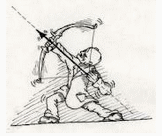HOW THE CURRENT MARKET PICTURE STACKS UP AGAINST THE CURRENT SENTIMENT PICTURE
Given the state of information indigestion that is prevalent in today's financial world, it is only proper that I begin this with a little bit of history. History in this case is a little over one month ago. It was at that time I posted an article titled, "Using The Put/Call Ratio To Forecast 5% Correction." The conclusion that was reached as a result of observing the put/call ratio on March 30th was that the stock market was, at a minimum, one month away from a correction of any substance. Sentiment, however, is but one tool in an investor or trader's arsenal of weapons. It must be used selectively based on the nature of the market at any given time. You can always sniff out an inexperienced investor by the level of importance they place on sentiment data alone. Often times an entire investment thesis and resulting portfolio structure will be based on one or a number of sentiment driven indicators without regard for anything else. A boiling pot of impending disappointment that sends the sentiment driven investor back to the drawing board eventually. Tonight we will look at two sides of the equation. First let's see what market action is telling us here. I'll go over these points in living color during this coming weekend's review: - The Dow Transports, arguably THE leader of the current rally, are exhibiting increasingly sloppy behavior, threatening to move below a key technical point. - Dow Industrials today thrust off of the key trajectory for 2013 pictured here. This is an indication that the market is growing uncomfortable with the slope of the current move. - IWM volume today was the greatest for a down day since September of 2011. It is not just the volume on a down day that is of concern. Perhaps more importantly, it is where that volume surge is occurring. In the case of IWM (Russell 2000) it is occurring right at the key trajectory from the October 2002 lows pictured here. A very significant development indicating that the market is recognizing the importance of a failure at this key trajectory. - The SOX is threatening to fail right at its key trajectory from the 1998 lows for the index. Now let's look at sentiment by looking over the combined put/call ratio using the 20 and 100 day moving averages only: click chart to enlarge If you are confused, then you are right where you should be. The market will also be confused, most likely resulting in choppy sideways action that leads both bulls and bears nowhere throughout the summer months. In this case, the preferred position is leaning towards an...
WHAT IS THE REAL STORY WITH MARKET SENTIMENT AT THIS JUNCTURE?
Measuring sentiment on Wall Street is perhaps the most subjective of all the analytic arts that is practiced on a day to day basis. It is one of the many tools out there that doesn't work until it does. Those who swear by it will be quick to point to the instances when it does as justification for future speculative positions that have no better chance of being correct than using a coin to determine whether to be long or short. Sentiment alone should not be used as the foundation for an investment thesis. You can always tell those who are inexperienced in dealing with sentiment by the level of importance they put on its readings. Those who base an entire investment thesis solely on sentiment are, in nearly every case, using sentiment as a psychological crutch to validate their prevailing bias. The truth about sentiment is that it will tell you whatever you want it to tell you at any given moment. Which is exactly why I choose to ignore sentiment measures, except when considered on the periphery of a strategy that takes into consideration numerous other factors first. During the end of March, I posted analysis showing how to use the put/call ratio (the only sentiment measure I look at consistently) to measure the point at which 5% corrections occur within the context of a bull market. This study solidified my belief that the chances of a 5% correction seeing its beginnings in April were slim to none. May looked like a better time frame to consider for such an event. Now is a good time to look at another measure of the put/call ratio. This time I want to look at a shorter-term measure of both the combined put/call ratio and the equity put/call ratio. The charts below are the 2 and 5 days moving averages for both of these put/calls. I use moving averages only to smooth out the results: click chart to enlarge As the charts above demonstrate, bears remain overly-anxious to regain their sanity through the creation of capital via put buying. Not necessarily what you want to see if you are hopefully bearish on the markets in the months ahead. This type of overzealous bearish investment behavior should not be occurring after such a powerful rally that has propelled the Dow and S&P 500 to all time highs. This leads me to believe that once this option expiration week passes, the markets should regain their footing for the remainder of April. I will reassess the sentiment picture again in...
USING THE PUT/CALL RATIO TO FORECAST 5% CORRECTIONS
It has been awhile since I looked into the put/call ratio to gauge whether sentiment has reached extreme levels. The reason I have turned my back on this indicator for most of the past 12 months is twofold. First, the technical work I was doing with respect to gauging tops and bottoms was working in such a harmonious manner that I didn't feel the need to muddle it up with noise. Second, WHEN you use any device to gauge price matters just as much as the device you are using. Allow me to amplify the second point by giving you a real life example of WHEN being of consequence. Take the man who decides to go hang out at a bar. If that man goes and takes a shot of tequila at 9 a.m. on a Wednesday, he will be seen as an irresponsible person with drinking problems. If that same man is to go the same bar 12 hours later at 9 p.m., takes his shot and laughs with some friends, he will be seen as a guy who just likes to party. When matters. Similarly, in the markets, WHEN you use an indicator can be the difference between being a floundering amateur or an upstanding professional. Certain indicators will work brilliantly under the right set of circumstances. They will also fail miserably under circumstances that aren't well suited to using that particular indicator. Just like a bad relationship, the key is knowing when to walk away. The put/call ratio may be at a point now that it can be useful again in the presence of numerous sentiment indicators that have been failing since January. There has been a consistent tendency to judge market participants as being excessively bullish, whether due to sentiment surveys, levels of margin debt or the run of the mill anecdotal evidence that pops up every few weeks. With the put/call ratio I like to use moving averages only. I also like to look at things like the length of time between the moving averages crossing over. The reason being that a short-term moving average crossing below a long-term moving average is a sign of a persistent shift in sentiment as opposed to anything temporary. The longer that shift remains in place, the more comfortable market participants are becoming with the foundation of the prevailing psychology. In the chart below you will see that the 20 day moving average of the total put/call ratio recently cross below the 100 day moving average. I go over what it means, along with what the absolute levels of sentiment according to the moving averages are telling us...
WEDNESDAY WAS THE BEGINNING OF THE PROCESS THAT WILL END THE CURRENT MARKET DECLINE
140 characters doesn't serve justice to certain market situations and scenarios. We are in the middle of one of those scenarios now. In order to demonstrate my thinking appropriately, I need a bit more amplification than 140 characters allows. I made a comment on Twitter during trading hours regarding the spike in put/call ratio as the S&P 500 had a rendezvous with the trajectory from the 2009 lows. The very same trajectory that carved out the low in October of 2011 that I bought hand over fist. The identical trajectory that gave us our low in June that was brought to you in living color days before it happened by yours truly. That same trajectory that is now acting as a floor to keep the market from diving off a technical cliff. And the touch of the trajectory is occurring with a spike in pessimism. The perfect recipe. I did make a declaration on Twitter that today's low may be it for the month of November. We are now in the zone where a bottom will more than likely be taking shape over the next few weeks. It could indeed be true that the low for the remainder of 2012 occurred today. At the very least, we have started the process of ending the decline. I'll say it again, today was the first day of the beginning of the process that will end the current decline. Let's take a look at a couple of charts, with notes included, as always. The first shows you the importance of the trajectory we came a hair away from touching today. The second is a demonstration of the put/call ratio with the S&P 500 charted below it: click chart to...
AMAZINGLY ENOUGH, IT IS JANUARY ALL OVER AGAIN
It is my duty to bring you, my dear patrons, the freshest and most reliable information with respect to the markets available. That is why I am persistent in my chase to dig deep into areas that few others bother to look. I am not simply going to sit here and show you a head and shoulders pattern, followed by a couple moving averages, giving you a elementary summary of what it is the markets are slated to do. The kiddie pool is over there. This is an arena for dignified adults seeking stimulation of the mental variety that reverberates into exquisite displays of prosperity if executed properly. With that said, I bring you my most recent postulation. The following study is the cousin of a study I posted on January 31st, 2012 titled, "A Fascintating Interpretation Of The VIX & Put/Call Ratios: Volume 2." The basic premise was that during bull markets put/call ratios and the VIX are no longer contrary indicators but rather serve little purpose other than to create conversation among pseudo-market intellectuals of which there are many in financial social media circles. In this study we look at both the Dow and short-term moving averages of the put/call ratio to gauge sentiment. There are some striking similarities to January of this year when another rally was just on the verge of getting underway. click chart to...
AMONG THE CASUALTIES OF THE MARKET: SENTIMENT
There are times sentiment studies can be the most valuable tool one can have in their arsenal. There are also times to dump it in a toilet filled with old cigarette butts and clipped toenails. What separates the professional from the amateur is knowing when to use what. There are times to pull out your AK-47 during a battle and there are other times when it is better to use a hunting knife. WHEN matters. I haven't talked about sentiment for awhile because it is useless in a market that is caught in the mid-range of its bullish life cycle. It only becomes useful at extremes of one sort or another. Those extremes may involve highly oversold conditions, based on panic driven selling. Highly overbought conditions, based on pure greed. A break of an important generational trajectory point. A break of round number or important support level. We are now entering a moment in time when I am watching sentiment again. I'll tell you why: Something curious is happening during this recent selling that I just started paying attention to today. There seems to be a general lack of fear that has developed. While the Russell 2000, as one example, is sitting at one month lows, a short-term measure of the put/call ratio I track is sitting at near 3 month lows (see chart below). I am starting to pay attention now because of the following bearish technical events that have taken place over the past several trading days: 1. Dow failed the important generational trajectory for a third time on Friday. Death comes in 3s and 4s for bull markets. I said in the weekend review to "remain vigilant." 2. The Russell broke down and away from its generational trajectory as of the close today. 3. The VIX experienced a powerful breakout above its trajectory off the 2008 highs today. In the meantime, the chart below shows sentiment is actually becoming more bullish as these important trajectory points are broken: click chart to...
MEASURING THE VELOCITY OF FEAR DELIVERS A CURIOUS MESSAGE
By traditional standards it has become accepted practice to look at the wide variety of sentiment based indicators that exist, designate a number based on historical relevance that tells of optimistic or pessimistic feelings and then attempt to construe whether a market should bought or sold. While this may seem like a potentially profitable practice, I am here to tell you that it only gives you a slight edge. Possibly no edge at all given that we are all now contrarians and we are all looking at the same data to develop contrarian-based ideas about the market. I am here to tell you that the competent investor seeking a greater edge must delve deeper. You can't simply look at arbitrary statistics and deem that it is time to buy or sell. Tear those statistics apart by finding new, innovate ways of measuring them. I attempted to that with my series titled "A Fascinating Interpretation of the Put/Call Ratio: Volume 1" posted in January. And followed up with a couple more ways of interpreting the put/call. If you read the articles, you will see how spot on the studies proved to be. On January 14th, I proclaimed the following as a result of my findings from these studies: If this study holds correct, then we can expect a top to approach around the April-May time frame, with the Dow seeing 13,000 and the S&P 1350 before all is said and done. Tonight I decided to reveal another study given the crucial space in time we are currently in with relation to the financial markets and the macro-events that are influencing the day to day volatility. In this study, I looked at the influence that a parabolic rise in pessimism as measured by the put/call ratio has on the markets over a 1 month and 3 month time frame. I am using the 2 day and 5 day moving averages of the combined put/call ratio for the data and MACD to measure the velocity of the increase. Over the past week we have experienced an extremely rare event. So rare that it has only taken place 3 times prior to now over the past 5 years. That event is a rise in pessimism that has so much velocity behind it that it drives the MACD reading on the 2/5 day put/call ratio over .08. In the chart that follows, I measured where the S&P 500 was 1 month and 3 months after such an event. A small sample size here doesn't take away from its significance: click chart to enlarge While I do believe that we will be significantly higher than...
PESSIMISM IS AT ITS HIGHEST POINT FOR 2012 ACCORDING TO ONE SHORT-TERM INDICATOR
I haven't talked sentiment in awhile mainly due to the fact that it doesn't work during bull markets. I abandoned sentiment surveys, put/call ratios and the like in early January and haven't looked back since. However, these types of short-term surveys of sentiment have some use. The 2 day and 5 day moving averages of the combined put/call ratio hit its highest level of 2012 this week. The market should respond by continuing forward the remainder of this week. It may do it slowly...but it will do it. Remember, if you are a bull, a low volatility, stable advance is ideal. If you are a bear you want shit to hit the fan as much as possible. Not in terms of news events or macro shakeups, but in terms of volatility and sloppy behavior. There has been very little in terms of anything volatile or sloppy taking place in the market in 2012. As long as this landscape remains in place, the advance continues. It is as simple as that. Here is the chart of the put/call with eloquent notes and elegant lines: click chart to...
A FASCINATING INTERPRETATION OF THE PUT/CALL RATIO: VOLUME 3
Misinterpretations of sentiment indicators are common in today's market. Traders have become accustomed to looking at raw data for these indicators, without any respect for historical reference. The put/call ratios can be extremely effective if smoothed out and viewed from a relative basis. You do that by using moving averages instead of raw data and zooming out. Today we take a look at the equity put/call ratio. Traders like to refer to this as a "dumb money" indicator. This comes from the idea that smaller, retail investors enjoy getting involved in equity options and professionals tend to gravitate towards index options. I am not sure that there is a "dumb money" class left in this market. When even the small pockets of retail investors have a general grasp of contrarian theory, the act of fading the next guy becomes an exercise in futility. It's like the story of a hedge fund manager that goes to an investment conference and the first question the presenter asks, "How many of you in this room are contrarians?" 80% of the attendees raise their hands. The chart below displays the 20 day and 100 day moving average of the equity put/call ratio only. The bottom graph displays the S&P 500. I have marked important, multi-month tops with the vertical blue lines. You can see that there seem to be some definite requirements of where the 100 day moving average needs to go before important tops in the market are observed. This becomes all the more pronounced following periods of excess pessimism that are marked by important tops in the 100 day moving average of the equity put/call. I have highlighted those tops with a green box. The conclusion here is that the bears may have a lot more waiting to do before a top of any significance is observed. click chart to...
A FASCINATING INTERPRETATION OF THE VIX & PUT/CALL RATIOS: VOLUME 2
Notes are on the chart. Per the usual, conventional wisdom regarding these two indicators is way off base here. Moving averages only to provide a clean price picture. click chart to enlarge












